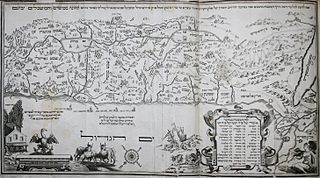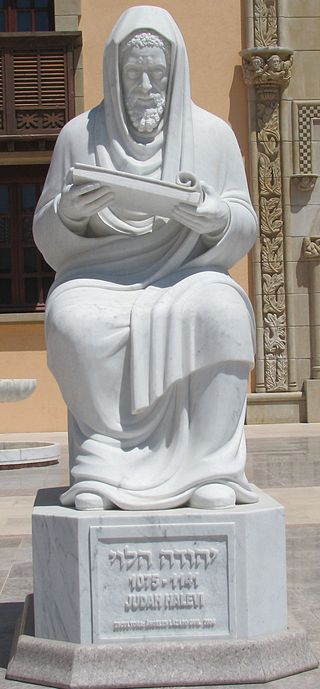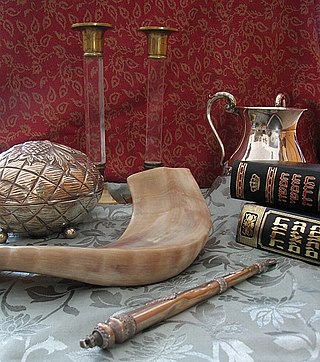
The history of ancient Israel and Judah begins in the Southern Levant region of Western Asia during the Late Bronze Age and Early Iron Age. "Israel" as a people or tribal confederation appears for the first time in the Merneptah Stele, an inscription from ancient Egypt that dates to about 1208 BCE, with the people group possibly being older. According to modern archaeology, ancient Israelite culture developed as an outgrowth from the Semitic Canaanites. Two related Israelite polities known as the Kingdom of Israel (Samaria) and the Kingdom of Judah had emerged in the region by Iron Age II.

The Kingdom of Judah was a Semitic-speaking kingdom of the Southern Levant during the Iron Age. Centered in the highlands of Judea, the kingdom's capital was Jerusalem. Jews are named after Judah and are primarily descended from it.

The Israelites were a group of Semitic-speaking tribes in the ancient Near East who, during the Iron Age, inhabited a part of Canaan.
Amoraim refers to Jewish scholars of the period from about 200 to 500 CE, who "said" or "told over" the teachings of the Oral Torah. They were primarily located in Babylonia and Ancient Palestine. Their legal discussions and debates were eventually codified in the Gemara. The Amoraim followed the Tannaim in the sequence of ancient Jewish scholars. The Tannaim were direct transmitters of uncodified oral tradition; the Amoraim expounded upon and clarified the oral law after its initial codification.

Jewish philosophy includes all philosophy carried out by Jews, or in relation to the religion of Judaism. Until modern Haskalah and Jewish emancipation, Jewish philosophy was preoccupied with attempts to reconcile coherent new ideas into the tradition of Rabbinic Judaism, thus organizing emergent ideas that are not necessarily Jewish into a uniquely Jewish scholastic framework and world-view. With their acceptance into modern society, Jews with secular educations embraced or developed entirely new philosophies to meet the demands of the world in which they now found themselves.

The major prophets is a grouping of books in the Christian Old Testament that does not occur in the Hebrew Bible. All of these books are traditionally regarded as authored by a prophet such as Jeremiah, Isaiah, Daniel, and Ezekiel. The term "major" has nothing to do with the achievement or importance of the prophets, rather with the length of the books. In comparison to the books of the Twelve Minor Prophets, whose books are short and grouped together into one single book in the Hebrew Bible, these books are much longer.

Judah Halevi was a Spanish Jewish physician, poet and philosopher. He was born in Spain, either in Toledo or Tudela, in 1075 or 1086, and died shortly after arriving in the Holy Land in 1141, at that point the Crusader Kingdom of Jerusalem.

The Kuzari, full title Book of Refutation and Proof on Behalf of the Despised Religion, also known as the Book of the Khazar, is one of the most famous works of the medieval Spanish Jewish philosopher and poet Judah Halevi, completed in the Hebrew year 4900 (1139-40CE).

The exilarch was the leader of the Jewish community in Persian Mesopotamia during the era of the Parthians, Sasanians and Abbasid Caliphate up until the Mongol invasion of Baghdad in 1258 CE, with intermittent gaps due to ongoing political developments. The exilarch was regarded by the Jewish community as the royal heir of the House of David and held a place of prominence as both a rabbinical authority and as a noble within the Persian court. Within the Sasanian Empire, the exilarch was the political equivalent of the Catholicos of the Christian Church of the East, and was thus responsible for community-specific organizational tasks such as running the rabbinical courts, collecting taxes from Jewish communities, supervising and providing financing for the Talmudic academies in Babylonia, and the charitable re-distribution and financial assistance to needy members of the exile community. The position of exilarch was hereditary, held in continuity by a family that traced its patrilineal descent from antiquity stemming from king David.

The Davidic line or House of David refers to the lineage of the Israelite king David. In Judaism it is based on texts from the Hebrew Bible and through the succeeding centuries based on later traditions. In Christianity, the New Testament follows the line through Mary and Joseph to Jesus.

Rabbinic Judaism, also called Rabbinism, Rabbinicism, or Judaism espoused by the Rabbanites, has been the mainstream form of Judaism since the 6th century CE, after the codification of the Babylonian Talmud. Rabbinic Judaism has its roots in the Pharisaic school of Second Temple Judaism, and is based on the belief that Moses at Mount Sinai received both the Written Torah and the Oral Torah from God. The Oral Torah, transmitted orally, explains the Written Torah. At first, it was forbidden to write down the Oral Torah, but after the destruction of the Second Temple, they decided to write it down in the Talmud and other rabbinic texts for preservation.
Judah ben Samuel of Regensburg, also called Yehuda HeHasid or 'Judah the Pious' in Hebrew, was a leader of the Chassidei Ashkenaz, a movement of Jewish mysticism in Germany considered different from the 18th-century Hasidic movement founded by the Baal Shem Tov.

Ben-Hur: A Tale of the Christ is a novel by Lew Wallace, published by Harper and Brothers on November 12, 1880, and considered "the most influential Christian book of the nineteenth century". It became a best-selling American novel, surpassing Harriet Beecher Stowe's Uncle Tom's Cabin (1852) in sales. The book also inspired other novels with biblical settings and was adapted for the stage and motion picture productions.

Ben-Hur is a 1959 American epic religious film directed by William Wyler, produced by Sam Zimbalist, and starring Charlton Heston as the title character. A remake of the 1925 silent film with a similar title, it was adapted from Lew Wallace's 1880 novel Ben-Hur: A Tale of the Christ. The screenplay is credited to Karl Tunberg, but includes contributions from Maxwell Anderson, S. N. Behrman, Gore Vidal, and Christopher Fry.
Isaac ben Moses of Vienna, also called Isaac Or Zarua or the Riaz, is considered to be one of the prominent rabbis of the Middle Ages. He was probably born in Bohemia and lived between 1200 and 1270. He attained his fame in Vienna and his major work, the halachic guide known as the Or Zarua a compilation of halachic decisions and legal rulings, was very popular among Ashkenazic Jewry. He was a member of the Chassidei Ashkenaz and studied under many scholars, including the Ra'avyah, Rabbi Yehudah HaChasid, the Sar mi'Kutzi and Rabbi Elazar Rokeach. He was among the teachers of Rabbi Meir of Rothenburg.
Judah ben Jehiel,, more usually called Judah Messer Leon, was an Italian rabbi, teacher, physician, and philosopher. Through his works, assimilating and embodying the intellectual approach of the best Italian universities of the time, yet setting it inside the intellectual culture of Jewish tradition, he is seen as a quintessential example of a hakham kolel, a scholar who excelled in both secular and rabbinic studies, the Hebrew equivalent of a Renaissance man. This was the ideal he tried to instil in his students. One of his students was Yohanan Alemanno.

The origins of Judaism lie in the Bronze Age amidst polytheistic ancient Semitic religions, specifically evolving out of the polytheistic ancient Canaanite religion, then co-existing with Babylonian religion, and syncretizing elements of Babylonian belief into the worship of Yahweh as reflected in the early prophetic books of the Hebrew Bible.

Edom was an ancient kingdom in Transjordan, located between Moab to the northeast, the Arabah to the west, and the Arabian Desert to the south and east. Most of its former territory is now divided between present-day southern Israel and Jordan. Edom appears in written sources relating to the late Bronze Age and to the Iron Age in the Levant.
The Land of Israel Gaonate was the chief talmudical academy and central legalistic body of the Jewish community in Palestine during the middle of the ninth century, or even earlier, till its demise during the 11th-century. During its existence, it competed with the Babylonian Gaonate for the support of the growing diasporic communities. The Egyptian and German Jews particularly regarded the Palestinian geonim as their spiritual leaders. The history of the gaonate was revealed in documents discovered in the Cairo genizah in 1896. Sparse information is available on the Palestinian geonim prior to the middle of the ninth century. The extant material consists essentially of a list in Seder Olam Zuta relating all the geonim to Mar Zutra.












